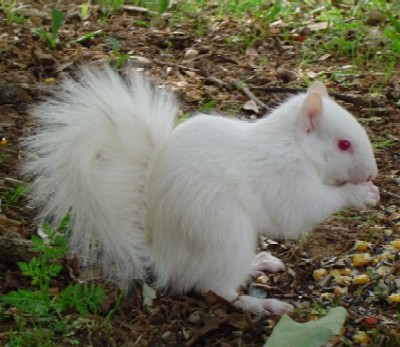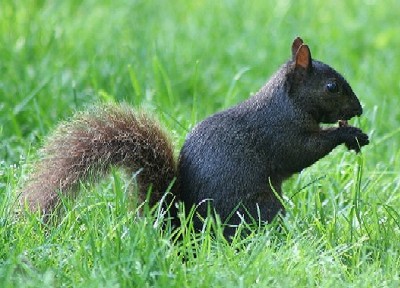Yahoo: “Salt & Pepper Squirrels” #1
Posted by: Loren Coleman on December 12th, 2006

The Once And Future University of North Texas White Squirrel.
A Cryptomundo correspondent at Princeton University just passed this along:
I see that your salt-and-pepper squirrel article made the # 1 spot (always reserved for cute critter pictures) on The 9 at Yahoo.Com. — my absolute favorite, must-watch M-F wrapup of the weird and wonderful on the World Wide Web:
Vote For #1 = “Salt & Pepper Squirrels”
Now you’ve really arrived, my man! Congratulations!
I appreciate this. Actually, the readers at Cryptomundo are the keys to our success. Thank you all for visiting, reading, and voting us Number #1, across the board, from albino squirrels to Bigfoot – even without polls.
BTW, of course, Yahoo is referring back to our 2006’s Top Ten White & Black Squirrels Hot Spots.

One of Washington State’s Melanistic Squirrels, perhaps a former Canadian? (See what I mean by this in the link right above.)
About Loren Coleman
Loren Coleman is one of the world’s leading cryptozoologists, some say “the” leading living cryptozoologist. Certainly, he is acknowledged as the current living American researcher and writer who has most popularized cryptozoology in the late 20th and early 21st centuries.
Starting his fieldwork and investigations in 1960, after traveling and trekking extensively in pursuit of cryptozoological mysteries, Coleman began writing to share his experiences in 1969. An honorary member of Ivan T. Sanderson’s Society for the Investigation of the Unexplained in the 1970s, Coleman has been bestowed with similar honorary memberships of the North Idaho College Cryptozoology Club in 1983, and in subsequent years, that of the British Columbia Scientific Cryptozoology Club, CryptoSafari International, and other international organizations. He was also a Life Member and Benefactor of the International Society of Cryptozoology (now-defunct).
Loren Coleman’s daily blog, as a member of the Cryptomundo Team, served as an ongoing avenue of communication for the ever-growing body of cryptozoo news from 2005 through 2013. He returned as an infrequent contributor beginning Halloween week of 2015.
Coleman is the founder in 2003, and current director of the International Cryptozoology Museum in Portland, Maine.










My wife an I spotted a black squirrel while bike riding on the C&O Canal Trail a few months back. Never knew they existed! Saw many white ones while in grad school up in Minneapolis years ago.
Wayne
I was surprised to see this black squirrel noted as special. I lived on John St. in Weston Ont years ago and we would sit and watch these animals playing in the street outside. My son also lives in Missasauga and we used to hand feed black squirrels on his balcony. I can honestly say that every squirrel I saw in Ontario was black. I assumed this was normal for the region. Never see a black one here in Nova Scotia though. Very interesting.
In the Washington, DC area (by all means not just the Zoo or the University of MD) there are thousands upon thousands of black squirrels. It’s a common (at least here) color phase of the eastern gray. In Silver Spring, MD, where I lived as a child, a lot of them had orange tails.
Lots of white ones? I’ve NEVER seen a white one.
I’ve multiple black squirrels in Brooklyn, New York. Never seen a white one though.
I have been waiting for someone to mention the White Tail KAIBAB squirrels, but I haven’t seen any comments about it. I think this squirrel deserves a mention in this squirrel discussion! This squirrel can be found ONLY in the Kaibab National Forest in Arizona. I’m not sure what color the body of the squirrel is (either grey or brown, I think), but its tail is pure white! Try spotting one of THOSE in your back yard! It is found only on a certain mesa in this park. I have several postcards of it in my ‘odd animal’ postcard collection.
My Departed Gram was an avid bird and small wildlife observer. She had a strange heirarchy for preference of squirrels by color: grey squirrels being good, red squirrel got shot at through her window screen. She often referred to black squirrels as well, and as such, I always assumed they were established and common. She could generally name just about any bird in our area, so I never questioned her.
Just wanted to add that “our area” is Western New York- not far from the Ontario poster who referred to them as common as well.
I live in the northwest corner of Washington State. My wife and I have a squirrel feeder in our side yard. Originally we only ever saw the small native red squirrel during the day and an occasional flying squirrel at night. We first noticed a little larger non-native gray squirrel last year. This year we have been regularly visited by a much larger black squirrel (almost twice the size of the original native red squirrel). It is my understanding that both the grey and black squirrels have emigrated down from British Columbia where they are both quite common. Since seeing the larger black squirrel, none of the other squirrels have been seen.
Also while living in Louisiana as a youngster, I regularly came across a black variety of fox squirrel, a very large squirrel. They are (or were – don’t know as I have not been there since the 70’s)) quite common on the Louisiana State University campus in Baton Rouge.
I no longer hunt, but when I was much younger I once “harvested” a squirrel that had the same coloration as seen in a calico cat – mottled reddish brown, gray, black, and white in an irregular pattern. My guess is that it could have been a hybrid resulting from gray and fox squirrel parents. I should have had it preserved by a taxidermist, but at thirteen years old, who has the money for that?
I don’t know if this location has been mentioned yet, but I’ve seen black squirrels (Abert’s) at Florissant Fossil Beds National Monument in Colorado. You can see a picture of one here.
I loved reading about all the little squirrels! I recently moved to the southern part of Illinois to OLNEY (home of the white squirrel, yes). Even the police have it on their cars. I have a big yard with lots of trees and many whites, greys and mixed squirrels hang out here. The mixed are referred to as “calico”. They are white AND grey and beautiful. I have been able to hand feed peanuts to a few of the whities. If you would like a pic of a calico, email me. ciao
I mentioned this before, but there ia a small group of black squirrels in central Indiana in the towns of Alexandria and Elwood in Madison County. They are not considered all that unusual. I’ve seen and photographed them and, personally, I think they are truly beautiful. Never saw one until I moved up here from southern Indiana.
There’s a well-established colony of melanistic red squirrels on the Rotheschilde Estate in Tring, Hertfordshire, UK. They’re unusual not just for being black, but because the red squirrel is endangered and slowly dying out thanks to the invading grey squirrel.
Kent, Ohio – Wooster, Ohio – Ashland, Ohio (maybe). Those cities have black squirrels. I’ve seen white ones in Elyria, Ohio & Wakeman, Ohio. I wasn’t aware that it was a big deal.
You’re serious? Color variation in squirrels is rare? As a child we had Grey, black and red squirrels in our suburban MD home outside Washington, DC. Where I live now the population is an even split between Grey and Black. As a child, older kids in the neighborhood rewrote the Sonny Charles 1969 song “Black Pearl, Precious little girl” into “Black squirrel, precious little squirrel” each time we’d spy one while we played in the yard in the early 70s.
There’s a recent report out of Russia about a pack of black squirrels attacking and killing a stray dog.